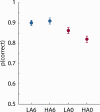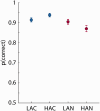Pupil Dilation Is Sensitive to Semantic Ambiguity and Acoustic Degradation
- PMID: 33124518
- PMCID: PMC7607724
- DOI: 10.1177/2331216520964068
Pupil Dilation Is Sensitive to Semantic Ambiguity and Acoustic Degradation
Abstract
Speech comprehension is challenged by background noise, acoustic interference, and linguistic factors, such as the presence of words with more than one meaning (homonyms and homophones). Previous work suggests that homophony in spoken language increases cognitive demand. Here, we measured pupil dilation-a physiological index of cognitive demand-while listeners heard high-ambiguity sentences, containing words with more than one meaning, or well-matched low-ambiguity sentences without ambiguous words. This semantic-ambiguity manipulation was crossed with an acoustic manipulation in two experiments. In Experiment 1, sentences were masked with 30-talker babble at 0 and +6 dB signal-to-noise ratio (SNR), and in Experiment 2, sentences were heard with or without a pink noise masker at -2 dB SNR. Speech comprehension was measured by asking listeners to judge the semantic relatedness of a visual probe word to the previous sentence. In both experiments, comprehension was lower for high- than for low-ambiguity sentences when SNRs were low. Pupils dilated more when sentences included ambiguous words, even when no noise was added (Experiment 2). Pupil also dilated more when SNRs were low. The effect of masking was larger than the effect of ambiguity for performance and pupil responses. This work demonstrates that the presence of homophones, a condition that is ubiquitous in natural language, increases cognitive demand and reduces intelligibility of speech heard with a noisy background.
Keywords: cognitive load; listening effort; pupillometry; semantic ambiguity; speech masking.
Conflict of interest statement
The authors declared no potential conflicts of interest with respect to the research, authorship, and/or publication of this article.
Figures






References
Publication types
MeSH terms
LinkOut - more resources
Full Text Sources
Miscellaneous

